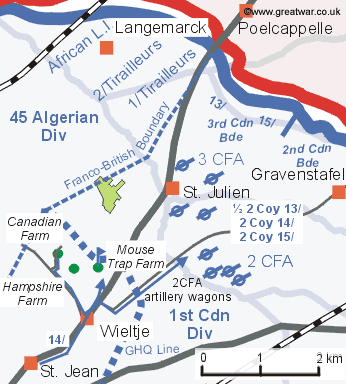 Canadian 3rd Brigade reserves “Stand to Arms”
Canadian 3rd Brigade reserves “Stand to Arms”
22 April 1915: 17.00
14th Battalion “Stands To” at St. Jean
At the time of the German attack the 14th Canadian Battalion was the reserve battalion in support of 3rd Canadian Brigade. Three of its four companies (No. 1, No. 3 and No. 4 Companies) were located at St. Jean.
Immediately the German attack was launched and the enemy bombardment became intense the 3rd Canadian Brigade commander, Brigadier-General R E W Turner, ordered the 14th Battalion to prepare to move from St. Jean to his headquarters at Mouse Trap Farm.
Mouse Trap Farm
Almost all the names shown on the British maps of the northern Ypres Salient were given to places, woods and farms during the battles of April and May 1915. The British names were not yet on maps being used at the time of the Second Battle of Ypres. Farms, woods and other locations were referred to by the trench map square reference. In the orders for the battle of Gravenstafel Ridge, for example, orders and messages referred to the farm subsequently called Mouse Trap Farm as the farm in square “C.22.b.”. On the Belgian maps being used for the basis of the British maps in early 1915 there were no names for the many farms in the area surrounding Ypres. Some were simply marked “Chateau”.
Mouse Trap Farm was one of these farms originally marked as “Chateau” on the Belgian map. It was known to the locals as “Chateau du Nord”. It was first called Shell Trap Farm by the British Army. Some units referred to it as Canadian Farm, because the 3rd Canadian Brigade had set up its headquarters there when it arrived in mid April 1915. The name Shell Trap did not seem very appropriate so the British V. Corps changed it to Mouse Trap. Another farm nearby became officially designated as Canadian Farm.
14th Battalion Witnesses Gassed French Troops

As the companies stood waiting by the roadside before moving off they witnessed an alarming sight of the terrified villagers of St. Jean mingling with the passing stream of wounded, gassed and panic-stricken French-Algerian troops retiring from their front line. Many of these small villages located only a few kilometres behind the front lines were still inhabited by the locals.
On their way to Mouse Trap Farm the three companies of 14th Battalion also saw the wagons of the 2nd Canadian Field Artillery Brigade's ammunition column rattling along the pavé (cobbled road) from its billets at Canadian Farm to resupply its batteries in the gun lines south of the Wieltje-Gravenstafel road. A boy of sixteen was the lead driver mounted on a horse on one of the wagon teams. In an attempt to avoid the enemy shells which were falling on the whole area he had managed to bring his six-horsed wagon safely through 6 kilometres of traffic and turmoil after his other comrades in the wagon team had been hit.
Two and a half Companies in 3rd Brigade Reserve “Stand To” in St. Julien
At 5pm Lieutenant-Colonel F O W Loomis, commanding officer of the 13th Canadian Battalion and Commandant of St. Julien, ordered his garrison to stand to arms. The troops at his disposal consisted of:
- 2 platoons of No. 3 Company from the 13th Battalion
- No. 2 Company from the 14th Battalion
- No. 2 Company from the 15th Battalion.
They were instructed to occupy their battle positions in the trenches presently under construction to the north of the village. Patrols and runners were sent forward to establish contact with the left end of the Canadian front line being held by the 13th Canadian Battalion.
About 200 Algerian riflemen from the French front line battalions of 1st and 2nd Tirailleurs had also joined the British garrison at St. Julien from the neighbouring 45th Algerian Division sector. A small reserve was also now held in St. Julien village. Two Colt machine guns of the 14th Canadian Battalion were mounted in the ruins.
St. Julien was also the Battalion Headquarters of Lieutenant-Colonel J A Currie of 15th Canadian Battalion, presently located in the front line to the right of 13th Battalion. German shells rained down on the village.
Next>> German accounts of the gas cloud
Acknowledgements
Official History of the Canadian Forces in The Great War 1914-1919, p. 231
British Military Operations: France and Belgium 1915, p. 175, p. 178